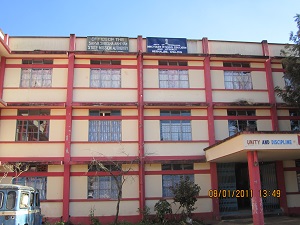- Skip to content
- Screen Reader Access
- Text Size:


 Samagra Shiksha Abhiyan, an integrated Scheme for School Education extending from Pre-school to
class-XII has been approved by the Cabinet Committee on Economic Affairs (CCEA) in the month of April,
2018. The Scheme provides that it will be implemented as a centrally Sponsored Scheme by the Department
through a single State Implementation Society (SIS) at the State Level. The scheme has been rolled out
across all the state from the financial year 2018-19.
Samagra Shiksha Abhiyan, an integrated Scheme for School Education extending from Pre-school to
class-XII has been approved by the Cabinet Committee on Economic Affairs (CCEA) in the month of April,
2018. The Scheme provides that it will be implemented as a centrally Sponsored Scheme by the Department
through a single State Implementation Society (SIS) at the State Level. The scheme has been rolled out
across all the state from the financial year 2018-19.
The Samagra Shiksha, An Integrated Scheme on School Education envisages the school as a continuum
from pre-school , primary, upper primary, secondary to Senior Secondary levels. The vision of the Scheme
is to ensure inclusive and equitable quality education from pre-school to senior secondary stage in
accordance with the Sustainable Development Goal (SDG) for Education.
The Union Budget, 2018-19, has proposed to treat school education holistically without segmentation
from pre-nursery to Class 12. Samagra Shiksha - an overarching programme for the school education
sector extending from pre-school to class 12 has been, therefore, prepared with the broader goal of
improving school effectiveness measured in terms of equal opportunities for schooling and equitable
learning outcomes. It subsumes the three erstwhile Schemes of Sarva Shiksha Abhiyan (SSA), Rashtriya
Madhyamik Shiksha Abhiyan (RMSA) and Teacher Education (TE).
The major objectives of the Scheme are provision of quality education and enhancing learning outcomes of students; Bridging Social and Gender Gaps in School Education; Ensuring equity and inclusion at all levels of school education; Ensuring minimum standards in schooling provisions; Promoting Vocationalisation of education; Support States in implementation of Right of Children to Free and Compulsory Education (RTE) Act, 2009; and Strengthening and up-gradation of SCERTs/State Institutes of Education and DIET as a nodal agencies for teacher training. The main outcomes of theScheme are envisaged as Universal Access, Equity and Quality, promoting Vocationalisation of Education and strengthening of Teacher Education Institutions (TEIs).
Implementation of Sarva Shiksha Abhiyan, Meghalaya: Sarva Shiksha Abhiyan (SSA) is Government of India’s flagship programme for achievement of Universalization of Elementary Education (UEE) in a time bound manner. The scheme was started in 2001 after modifying existing schemes such as District Primary Education Programme (DPEP). The programme got legal and constitutional backing after 86th amendment, which made free and compulsory Education to the Children of 6-14 years age group, a Fundamental Right. SSA is being implemented in partnership with State Governments to cover the entire country. The ratio of funding pattern between the Central govt. and the State Govt. is 90:10. Initially span of SSA was from 2001 to 2010 and it has been extended beyond 2010 and subsequently it was extended beyond. The Sarva Shiksha Abhiyan Mission strives to secure the right to quality basic education for all children in the 6-14 years age group. The Goals of the SSA Mission are:-
To achieve this SSA became a colossal scheme of free education with free textbooks in all regional languages, free uniforms, and free mid-day meal. In particular, SSA became popular and successful because of the mid-day meal scheme which directly hiked the enrolment rate in rural areas.As per guidelines of SSA Framework, state prepares the annual work plan and budget which is then submitted to the government of India for its sanction. Project approval Board of the GOI approves the annual work plan and budget of the state. State extends its commitment for the state share of the approved budget and GOI releases the funds in instalments.
Implementation of Rashtriya Madhyamik Shiksha Abhiyan, Meghalaya: Rashtriya Madhyamik Shiksha Abhiyan (RMSA) is a Programme of the Government of India, implemented in partnership with the State Governments with the main objective to make secondary education of good quality available, accessible and affordable to all young persons. The scheme seeks to enhance enrolment in classes IX and X by providing a secondary school within a reasonable distance of every habitation, to improve quality of education imparted at secondary level by ensuring all secondary schools conform to prescribed/ standard norms, to remove gender, socioeconomic and disability barriers and to achieve universal access to secondary level education by 2017, i.e. by the end of the 12th Five Year Plan. The main objective of the RMSA program as envisage by the framework for implementation of RMSA is to make good quality education available, accessible and affordable to all persons in the age group 14-18 years. With this vision, further the following has to be achieved: